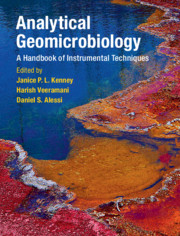Book contents
- Analytical Geomicrobiology A Handbook of Instrumental Techniques
- Analytical Geomicrobiology
- Copyright page
- Contents
- Contributors
- Foreword
- Part I Standard Techniques in Geomicrobiology
- Part II Advanced Analytical Instrumentation
- 2 The Application of Isothermal Titration Calorimetry for Investigating Proton and Metal Interactions on Microbial Surfaces
- 3 Potentiometric Titrations to Characterize the Reactivity of Geomicrobial Surfaces
- 4 Use of Multi-collector ICP-MS for Studying Biogeochemical Metal Cycling
- Part III Imaging Techniques
- Part IV Spectroscopy
- Part V Microbiological Techniques
- Index
- References
3 - Potentiometric Titrations to Characterize the Reactivity of Geomicrobial Surfaces
from Part II - Advanced Analytical Instrumentation
Published online by Cambridge University Press: 06 July 2019
- Analytical Geomicrobiology A Handbook of Instrumental Techniques
- Analytical Geomicrobiology
- Copyright page
- Contents
- Contributors
- Foreword
- Part I Standard Techniques in Geomicrobiology
- Part II Advanced Analytical Instrumentation
- 2 The Application of Isothermal Titration Calorimetry for Investigating Proton and Metal Interactions on Microbial Surfaces
- 3 Potentiometric Titrations to Characterize the Reactivity of Geomicrobial Surfaces
- 4 Use of Multi-collector ICP-MS for Studying Biogeochemical Metal Cycling
- Part III Imaging Techniques
- Part IV Spectroscopy
- Part V Microbiological Techniques
- Index
- References
Summary
Potentiometric titrations are a widely used technique to quantify proton-active functional groups on microorganisms, their exudates, biominerals, and biofilms. In this chapter, we provide a step-by-step introduction to the preparation of microbial cells for the determination of proton buffering capacity using modern autotitration systems. Following a discussion of how to process titration data and plot titration curves, we review commonly used thermodynamic approaches to model titration curves in order to calculate cell wall functional group acidity constants and corresponding site concentrations. In geomicrobiology, protonation models are primarily used as a basis for the development of surface complexation models that can predict the adsorption of charged species such as metals to biomass. The case example that follows outlines the development of a surface complexation model for the adsorption of cadmium to a species of the marine cyanobacterium Synechococcus, using a protonation model developed from titration data as its basis. In the last section, we introduce the reader to other analytical tools that are complementary to titration results, and discuss a few common complications to the titration approach when it is applied to natural materials.
- Type
- Chapter
- Information
- Analytical GeomicrobiologyA Handbook of Instrumental Techniques, pp. 79 - 92Publisher: Cambridge University PressPrint publication year: 2019
References
3.6 References
- 2
- Cited by



